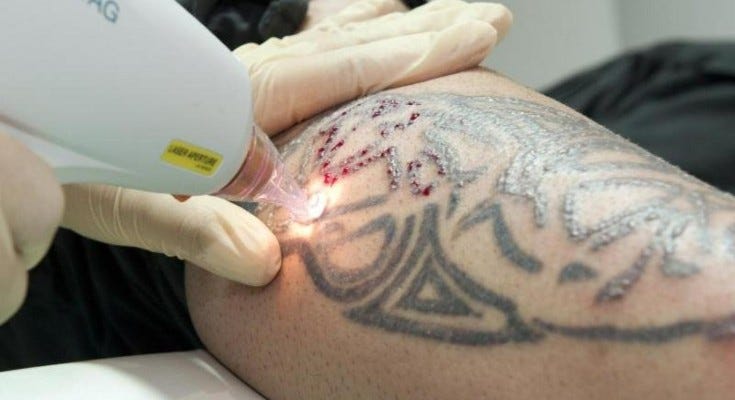Tattoos have been a form of self-expression for centuries, allowing individuals to decorate their bodies with meaningful designs, commemorate special events, or simply showcase their personal style. However, as time passes, the significance of a tattoo may change, leading some to reconsider their inked decisions. This shift in perspective has made tattoo removal techniques increasingly popular, offering a chance for individuals to erase their past tattoos and start anew. Tattoo removal has evolved significantly, with advanced techniques that promise a clean slate without the need for surgical intervention.
The Journey from Ink to Removal
People opt for tattoos for various reasons, ranging from artistic expression and personal milestones to love declarations and the desire to belong to a group. Tattoos often symbolize a particular phase in life, a reminder of the journey one has traveled. However, as life unfolds, the tattoos that once held profound meaning can become misaligned with an individual’s current identity or lifestyle. The reasons for seeking tattoo removal are as diverse as the motives for getting inked. These can include professional considerations, where a visible tattoo may not align with workplace norms, changes in personal taste, or the end of a relationship that a tattoo commemorates.
Moreover, regret can be a powerful motivator. What once seemed like a good idea in the spur of the moment can later become a source of dissatisfaction or embarrassment. In other instances, the quality of the tattoo work or the natural aging of the skin can affect the appearance of tattoos, prompting individuals to seek removal options.
Navigating the Path to Tattoo Removal
The journey of tattoo removal is one that requires patience, commitment, and a clear understanding of the available techniques. Advances in technology have brought about non-surgical methods that are effective, safer, and less painful compared to traditional methods. These advancements have made the process more accessible and appealing to those looking to part ways with their tattoos.
Laser tattoo removal is at the forefront of non-surgical tattoo removal techniques. This method uses high-intensity light beams to break down the ink particles in the skin, which are then naturally eliminated by the body’s immune system. The process is precise, allowing for the removal of specific tattoo areas without damaging the surrounding skin. Different types of lasers are tailored to remove various ink colors, making it a versatile option for many.
Another innovative technique is the use of picosecond lasers, which emit light in ultra-short pulses. This method is effective in removing tattoos more quickly and with fewer sessions compared to traditional laser treatments. Picosecond lasers are particularly adept at dealing with challenging ink colors and can reduce the risk of skin damage.
Intense Pulsed Light (IPL) therapy is another non-invasive option. Though similar to laser therapy, IPL uses a broad spectrum of light to remove tattoos. It is considered less painful and can be more effective for certain types of skin and ink colors. However, IPL might require more sessions than laser treatments for complete tattoo removal.
What to Consider Before Going Forward
Embarking on the journey of tattoo removal requires careful consideration of several factors. Firstly, understanding the commitment involved is crucial. Tattoo removal typically requires multiple sessions, with the number depending on the size, color, and age of the tattoo, as well as the depth of the ink. Sessions must be spaced out to allow the skin to heal, making the process a potentially lengthy one.
The choice of technique is another important consideration. Factors such as skin type, tattoo complexity, and individual health should guide this decision. Consulting with a professional who specializes in tattoo removal can provide valuable insights and recommendations tailored to one’s specific situation.
Cost is also a significant factor. Tattoo removal can be an investment, with the total expense varying based on the number of sessions required and the technique used. Understanding the financial aspect and planning accordingly is essential for a smooth tattoo removal journey.
Lastly, managing expectations is key. While advanced techniques offer impressive results, achieving a completely clean slate may not be possible for every tattoo. Some may experience light scarring or faint remnants of the tattoo. Open and honest communication with the removal specialist can help set realistic expectations and ensure satisfaction with the outcome.
Embracing a Future Without Ink
Tattoo removal offers a path to transformation for those seeking to reclaim their skin and erase reminders of the past. With the advent of advanced non-surgical techniques, the process has become more effective and accessible, providing a beacon of hope for a clean slate. Whether motivated by personal growth, professional reasons, or a change in aesthetics, the journey of tattoo removal is a testament to the human desire for renewal and change.
As the field of tattoo removal continues to evolve, the promise of starting anew becomes more attainable. By carefully considering the reasons for removal, understanding the process, and choosing the right technique, individuals can navigate this journey with confidence. Tattoo removal is not just about erasing ink; it’s about offering a second chance for those wishing to redefine their stories and embrace a future without constraints.
Conclusion
The journey from deciding to remove a tattoo to achieving the desired outcome is a personal and transformative experience. It highlights the importance of self-reflection, the willingness to embrace change, and the pursuit of personal satisfaction. As technology advances, the possibilities for tattoo removal will continue to expand, providing even more individuals with the opportunity to start afresh. In this journey of erasing the past and looking forward to the future, tattoo removal stands as a powerful symbol of renewal and possibility.

